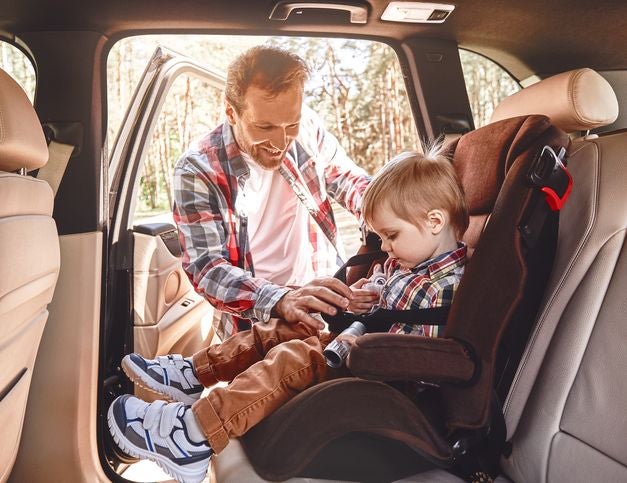Car Safety

The first U.S. patent for an automobile seatbelt was issued in 1885, but the first modern, 3-point seatbelt wasn’t installed in vehicles until 1959, and the first seat belt law didn’t come into play until 1968. Car seats were first created in the 1930s, but they were just for containing kids and letting them look out the window; it wasn’t until the 1960’s that the idea of car seats as safety devices came on the scene. In the nearly 50 years since then, car safety guidelines have changed quite a bit, and car seats are safer than ever. Are you doing everything you can to promote car safety for your kids?
- We all know that infant car seats are important, since the hospital won’t let you take the baby home without one. Little babies should be in a rear-facing car seat in the back seat, because that’s the best way to protect their heads and spines. A baby in the front seat is at risk from the airbags, and if he or she is forward facing or at the wrong recline angle, there’s a risk of restricting the airway.
- Use infant car seats the right way. Never hang toys from the carrier handle, because they could become flying projectiles in the event of an accident. Don’t put your baby in the infant seat in a puffy winter coat, because during a crash the coat can compress and make the baby less secure. Out of the car, don’t put the infant seat anywhere unsafe, like the top of a grocery cart or on a soft surface, and never let your baby nap in the car seat, because that raises the risk of sudden infant death syndrome (SIDS).
- As your baby grows, car seat safety is still just as important. Always know where your child is before you start your car, and use automatic door and window locks to keep your child safe. Follow the appropriate guidelines for when to move to a forward-facing seat or a booster, and use extreme caution if you’re considering a used car seat. Don’t let your kids transition to an adult seatbelt until they’re 4 feet 9 inches tall.
- Be aware that 46 percent of parents make a mistake when installing the car seat and putting the child into it. The seat should be tightly secured, with no more than an inch of movement from side to side or front to back. The harness must be secure, the chest clip even with the child’s armpits. Be careful to install car seats according to the manufacturer’s instructions, either using seatbelts or the LATCH system.
At the Center for Vasectomy Reversal, we love helping people build their families. Under the direction of Dr. Joshua Green, our team provides state-of-the-art treatment for men who need a reversal of their vasectomy or have other fertility concerns. To learn more, contact us through our website, or call 941-894-6428 for a free consultation.
Recent Posts
Popular Posts
categories
- Uncategorized
- Sperm Retrieval
- vasectomy reversal
- Emergency
- Dr. Green
- sperm count
- fertility
- male infertility
- MESA
- medical care
- low sperm count
- IVF
- male fertility testing
- anesthesia
- pregnancy
- sperm aspiration
- semen analysis
- post-vasectomy pain syndrome
- infertility
- VE
- anti-sperm antibodies
- older dad
- general anesthesia
- gender reveal party
- post-operative infections
- baby name
- parent
- baby's first year
- fertilization process
- spinal anesthesia
- ACS Fellow
- nutrition tips
- concierge-level care
- fertility planning app
- azoospermia
- out-of-town patients
- V-V
- post-vasectomy reversal
- conceiving
- vasectomy
- vasoepididymostomy
- smoking
- sperm quality
- baby registry
- infographic
- surgical care
- surgical consultation process
- prostate cancer
- baby gender
- family time
- COVID
- Baby Shower
- Child Care
- Halloween Costume Ideas for Babies
- Halloween
- Halloween Safety Tips
- Celebrity Infertility Spotlight
- Postpartum
- testosterone
- Father's Day
- Father
- Men's Health
- Thanksgiving
- Pregnancy Announcement
- Parenting Tips
- Sperm
